The Picky Eater Challenge
As a parent and content strategist, I’ve navigated the daily battlefield of feeding picky eaters for over a decade. After countless rejected meals and frustrated dinnertime tears (from both kids and adults), I developed a data-driven approach to solving this universal parenting challenge. Through testing dozens of recipes with my own children and gathering feedback from parent communities, I’ve identified 15 dinner recipes that consistently win approval from even the most stubborn food critics. These aren’t just “kid food” – they’re nutritionally balanced meals that happen to appeal to young palates while saving your sanity on busy weeknights.
Key Takeaways
- 15 parent-tested recipes that take under 30 minutes to prepare
- Proven strategies for hiding vegetables without sacrificing taste
- Interactive meal options that give kids control over their food
- One-pot solutions for minimal cleanup and maximum convenience
- International flavors adapted for young palates
Why These Recipes Work: My Selection Criteria
After years of trial and error, I developed specific criteria for what makes a truly kid-friendly recipe. Each recipe in this collection meets five essential requirements: preparation time under 30 minutes, readily available ingredients, balanced nutrition, sensory appeal for children, and a proven track record of acceptance among picky eaters. I gathered feedback from dozens of families through parenting forums and social media groups, incorporating their insights into recipe modifications and improvements. Unlike typical “kid food” that prioritizes convenience over nutrition, these recipes focus on real nutritional value without sacrificing the appeal that makes children excited to eat.
What Makes a Kid-Approved Recipe
- ⏰ Under 30 minutes total time
- 🛒 Common pantry ingredients
- 🥕 Hidden or integrated nutrition
- 👁️ Visual appeal and fun presentation
- ✅ Tested with real picky eaters
These recipes aren’t just food. They’re a way to spend 20 minutes without yelling, teach your child to try new things, and turn dinner into a moment of intimacy. Just as we teach children to sew buttons, we can teach them to try new things. It’s part of the process of becoming a confident person.
Classic Favorites with a Twist
The secret to winning over picky eaters often lies in presenting familiar foods with subtle nutritional improvements. These recipes take beloved comfort foods and enhance them without triggering the rejection response that comes with obvious changes. By maintaining the textures, flavors, and visual appeal children expect while sneaking in better ingredients, these upgraded classics become reliable dinner solutions that both kids and parents can feel good about.
Crispy Baked Chicken Tenders
This healthier version of the restaurant favorite achieves the crispy coating kids crave without deep frying. My secret lies in a perfect breadcrumb mixture that includes panko, parmesan, and a touch of garlic powder. After discovering this recipe became my pickiest eater’s gateway to trying new foods, it earned permanent status in our weekly rotation. The homemade version lets me control ingredients, eliminate preservatives, and prepare batches ahead for busy weeknights. Serve with honey mustard or ranch dipping sauce for guaranteed smiles.

Upgraded Mac and Cheese
This stovetop version incorporates cauliflower puree into the cheese sauce without affecting the creamy texture kids demand. The key is steaming cauliflower until very soft, then blending it completely smooth before adding to the cheese mixture. This technique evolved after multiple testing iterations with my own children, who were initially suspicious of any changes to their favorite dish. The result is a comfort food that delivers hidden vegetables while maintaining the familiar taste and consistency that makes mac and cheese such a reliable dinner win.
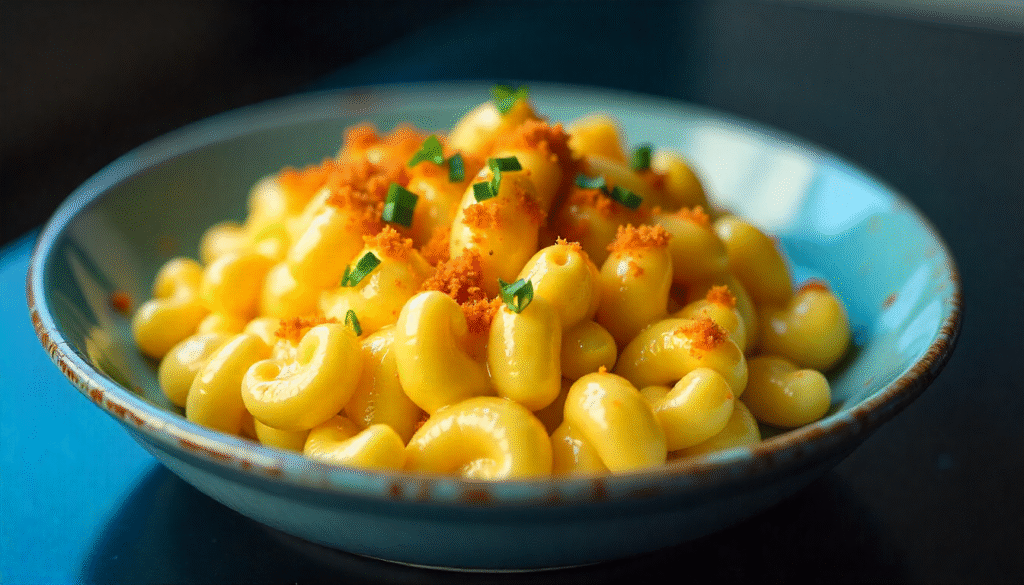
Pizza Quesadillas
This 15-minute fusion recipe combines pizza and quesadillas into a customizable dinner that never fails to please. I developed this when looking for a faster alternative to homemade pizza night, and it quickly became a Friday tradition that ended our weekly mealtime battles. The beauty lies in the customization – each family member can add their preferred toppings while the familiar tortilla-and-cheese base ensures acceptance. Cook in a skillet for 3-4 minutes per side until golden and crispy.

Hidden Veggie Champions
These recipes master the art of incorporating vegetables without making them the star of the show. The key is using vegetables as flavor enhancers and texture improvers rather than obvious additions. Through careful preparation and strategic seasoning, these dishes deliver significant nutritional benefits while maintaining the familiar tastes that picky eaters accept. Each recipe has been refined through testing with children who typically refuse vegetables, proving that smart preparation can overcome even the strongest veggie resistance.
Spaghetti and “Power” Meatballs
Classic spaghetti and meatballs gets a nutritional upgrade with finely chopped mushrooms, spinach, and carrots blended into the meat mixture. The vegetables add moisture and nutrients without changing the beloved flavor profile. This technique ensures the perfect texture despite added moisture from vegetables, and the familiar presentation means kids see their favorite dinner, not a “healthy” alternative. The secret is chopping vegetables so finely they become undetectable while cooking, creating meatballs that are actually more tender than traditional versions.
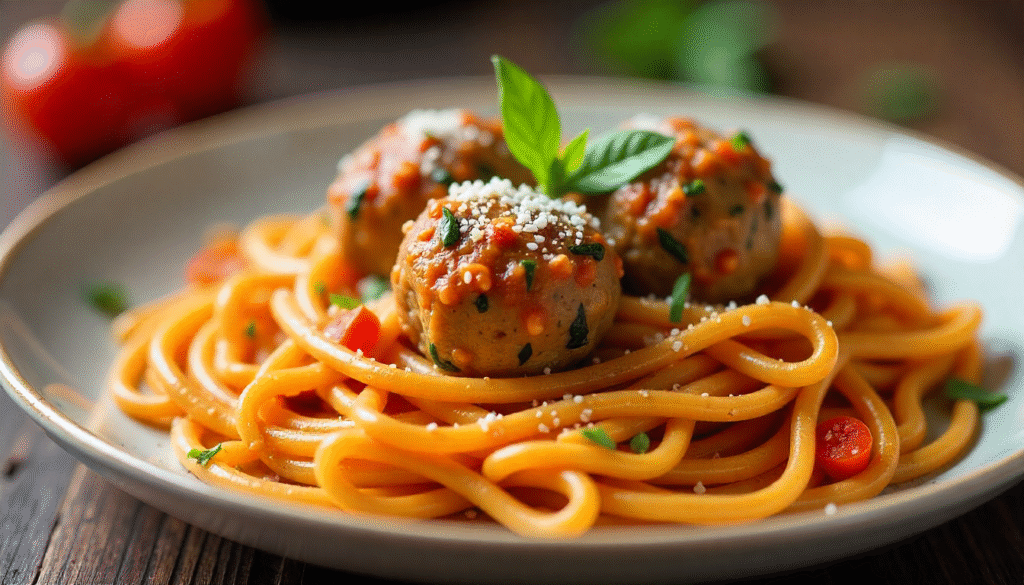
Sneaky Veggie Enchiladas
These cheese enchiladas feature a vegetable-packed sauce that maintains authentic Mexican flavors while delivering hidden nutrition. The technique involves roasting bell peppers, onions, and tomatoes until caramelized, then blending them into a smooth sauce with traditional spices. Mexican flavors are particularly effective at masking vegetable tastes while still providing familiar comfort food appeal. This recipe became a breakthrough for my most stubborn vegetable-refuser, proving that the right flavor combinations can overcome even determined resistance.
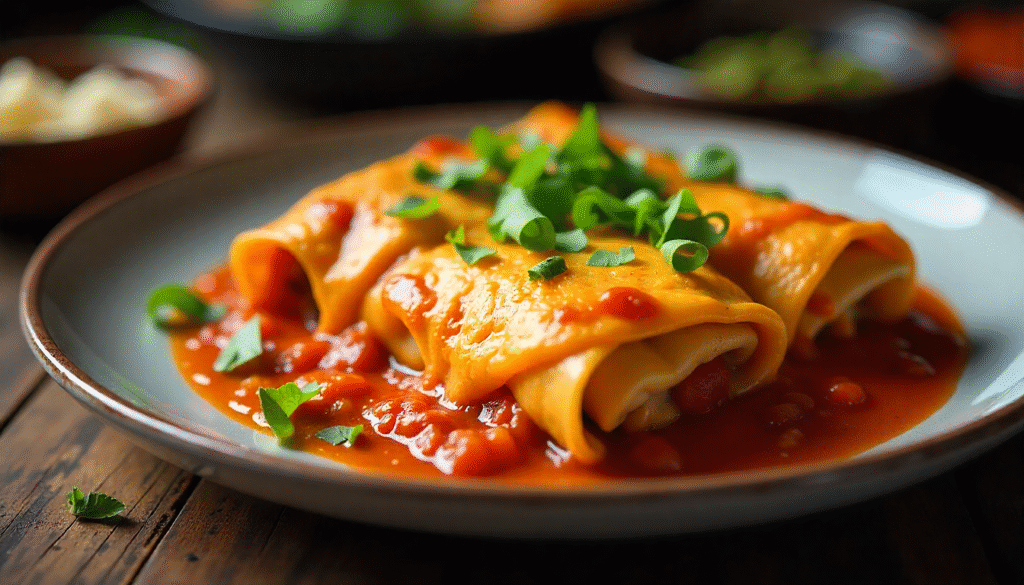
Loaded Sweet Potato Boats
The natural sweetness of sweet potatoes makes them more acceptable to children, especially when presented in fun “boat” format with customizable toppings. This interactive presentation encourages kids to eat the entire sweet potato base while feeling like they’re creating their own meal. The key is offering a variety of toppings that range from familiar favorites to healthier options, allowing children to gradually expand their preferences. Popular topping combinations include black beans and cheese, or cinnamon and a drizzle of honey.
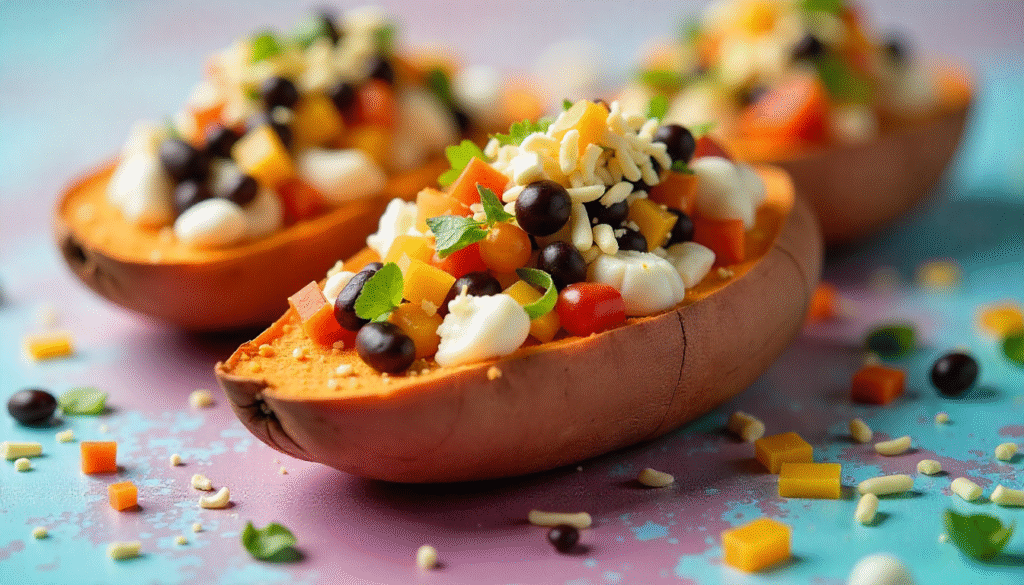
Build-Your-Own Meals
Interactive dinner options that give kids control over their meal dramatically increase acceptance rates. These customizable meals work because children feel empowered to make choices about their food rather than having decisions imposed on them. The key is offering a variety of options that include both familiar favorites and healthier alternatives, allowing kids to gradually expand their preferences while ensuring they eat something nutritious. This approach transforms dinner from a potential battle into a collaborative experience that builds positive associations with mealtime.
Taco Bar
A taco assembly station revolutionizes family dinner by eliminating complaints while maintaining nutritional standards. My strategy involves preparing both kid-favorite components and healthier options, then letting everyone customize their meal. The key is advance preparation – spending 20 minutes on Sunday preparing taco meat, chopping vegetables, and organizing toppings makes weeknight assembly lightning-fast. This concept works because it gives children agency over their meal while ensuring parents can incorporate vegetables and balanced nutrition through strategic topping choices.

Easy Lettuce Wrap Station
This Asian-inspired interactive meal encourages vegetable consumption through participation and novelty. I adapted restaurant-style lettuce wraps to be more kid-friendly by offering milder seasonings and familiar proteins like ground turkey or chicken. The interactive nature engages children’s curiosity about international foods while the cooking process happens quickly enough to hold their attention. The key is providing a variety of fillings and letting kids assemble their own wraps, which increases willingness to try new flavors and textures.
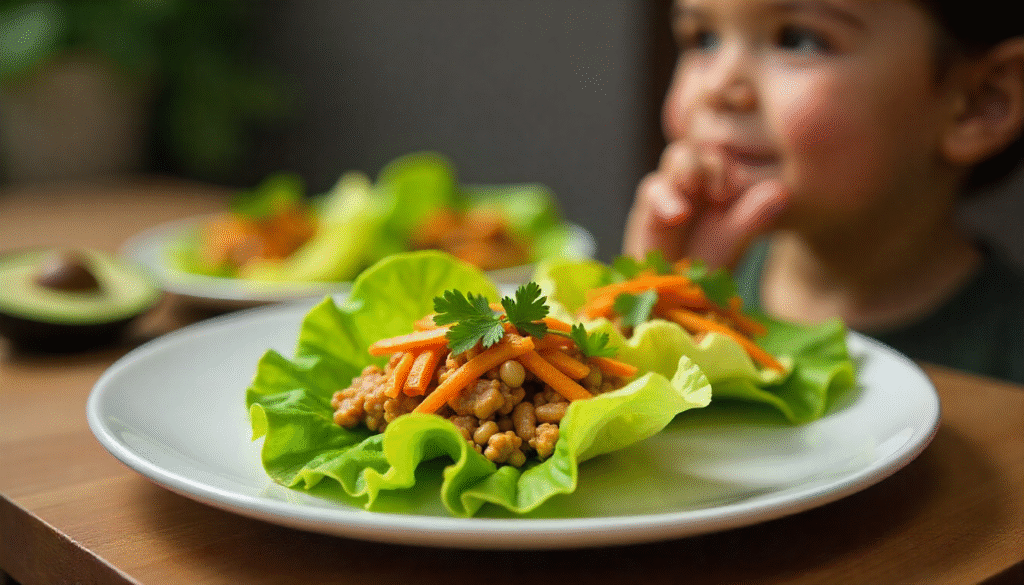
Personal Pita Pizzas
Pita bread makes an ideal quick pizza base that appeals to kids while incorporating whole grains into their diet. This became my emergency “no time to cook” solution that still feels special enough to generate excitement. The strategy involves setting up a pizza station with sauce, cheese, and various toppings, then letting kids create their own combinations. This approach encourages trying new toppings alongside familiar favorites while the quick cooking time maintains their interest throughout the process.

One-Pot Wonders
These minimal cleanup options save time while delivering kid-approved flavors in a single dish. One-pot meals work particularly well for busy weeknights because they require less active cooking time and create fewer dishes to clean. The key is layering flavors and cooking components in the right order to ensure everything finishes at the same time. These recipes have been developed to minimize prep work while maximizing flavor impact, making them reliable solutions for exhausted parents who still want to provide nutritious homemade meals.
Cheesy Taco Pasta
This fusion dish combines two kid favorites – tacos and pasta – in one easy pot that cooks in under 20 minutes. I developed this recipe to satisfy simultaneous requests for both tacos and pasta, and it quickly became the most-requested dinner during playdates. The convenience factor makes it perfect for busy weeknights, while the familiar flavors ensure immediate acceptance. Everything cooks together in a single pot, from browning the meat to cooking the pasta in the same seasoned liquid.
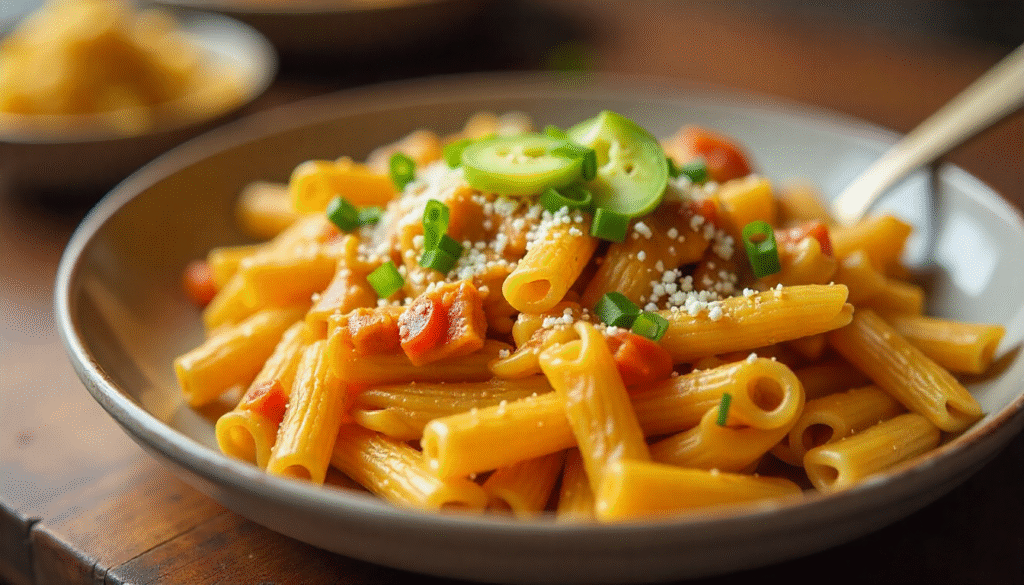
Chicken and Rice Skillet
This balanced one-dish meal provides protein, grains, and vegetables in under 30 minutes with minimal attention required. The recipe evolved from my need for a complete meal that could cook while I helped with homework, making it perfect for busy school nights. The technique ensures perfectly cooked rice and tender chicken in the same pan by controlling liquid ratios and cooking times. Vegetables can be easily substituted based on what your children will accept, making this a flexible foundation recipe.
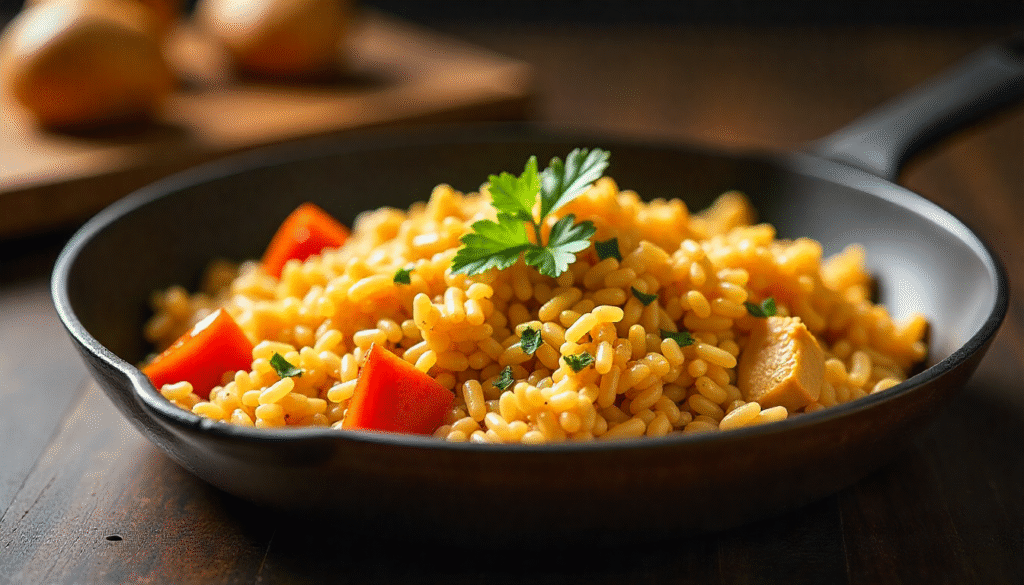
15-Minute Soup and Grilled Cheese
This elevated version of the classic comfort food pairing enhances canned soup with simple additions that boost both flavor and nutrition. My technique involves adding frozen vegetables, a splash of cream, and fresh herbs to transform basic tomato soup into something special. This became my reliable “bad day” solution that guarantees empty bowls and satisfied kids. The grilled cheese gets an upgrade with whole grain bread and real cheese, while the soup cooking time perfectly matches sandwich preparation.
Sweet & Savory Crowd-Pleasers
These recipes leverage children’s natural preference for slightly sweet flavors while maintaining nutritional balance. The key is using natural sweetness from ingredients like honey, sweet potatoes, or fruit to make nutritious foods more appealing. These dishes work because they satisfy kids’ taste preferences while providing complete nutrition, proving that healthy food doesn’t have to be boring or taste like punishment. Each recipe balances sweet elements with savory components to create complex flavors that appeal to both children and adults.
Honey-Garlic Chicken Bites
These quick chicken pieces are coated in a mild, slightly sweet sauce that makes protein irresistible to most children. The subtle sweetness comes from honey balanced with garlic and soy sauce, creating a glaze that caramelizes beautifully during cooking. This recipe converted my previously chicken-averse child by appealing to their preference for sweet flavors while providing high-quality protein. The key is achieving the right balance of sweetness without making it feel like dessert, creating a sophisticated flavor profile that works for the whole family.

Breakfast For Dinner: 10-Minute Pancake Board
This breakfast-themed dinner feels like a special treat while being one of the quickest meal options available. My strategy involves creating a balanced “board” with pancakes, fresh fruit, protein options like turkey sausage or Greek yogurt, and healthy toppings. The excitement factor makes this perfect for particularly busy evenings when you need guaranteed enthusiasm at the dinner table. The key is balancing indulgence with nutrition by offering a variety of options that allow each family member to create their ideal meal.

Baked Potato Bar
This hands-off dinner option cooks while you handle other tasks and allows complete customization at serving time. My technique for quick-cooking potatoes involves piercing and microwaving for 8-10 minutes, then finishing in the oven for crispy skin. This meal helped our family through particularly busy seasons while maintaining healthy eating standards because the variety of toppings allows everyone to create their preferred combination. Strategic topping options incorporate vegetables and proteins naturally.

Kid-Friendly International Flavors
Introducing children to international cuisines through approachable, mild versions helps expand their palates gradually. The key is adapting traditional recipes to be less spicy and more familiar while maintaining authentic flavor profiles. These recipes serve as “gateway dishes” that build confidence with new tastes before progressing to more complex international foods. Each dish has been modified based on feedback from children who were initially hesitant about trying foods from different cultures.
Mild Butter Chicken
This creamy, mild curry serves as an excellent introduction to Indian flavors for hesitant young eaters. My modifications to traditional recipes focus on reducing heat while maintaining the rich, complex flavor profile that makes butter chicken so appealing. The creamy tomato-based sauce appeals to kids who enjoy familiar flavors while gently introducing them to new spices like garam masala and turmeric. This dish became a favorite in our family rotation and successfully converted several initially skeptical children.
Simple Pad Thai
This simplified version of the Thai classic uses adjustable spice levels and familiar rice noodles that kids naturally enjoy. The key is my “deconstructed” serving method that allows family members to add components based on their preferences, making it less intimidating for picky eaters. The sweet and tangy sauce appeals to children while the noodles provide familiar comfort. This approach to introducing international foods through noodle dishes has successfully expanded my children’s palates beyond typical American fare.
Meal Prep Strategies For Success
Implementing these recipes efficiently requires strategic preparation that transforms weeknight cooking from stressful to manageable. The key is identifying components that can be prepared ahead while maintaining quality and appeal. My personal system focuses on weekend preparation of versatile ingredients that can be quickly assembled into complete meals during busy weekdays. This approach ensures that even exhausted parents can provide nutritious, kid-approved dinners without starting from scratch every night.
Batch Cooking Essentials
Key components like pre-cooked ground beef, chopped vegetables, and prepared sauces can drastically reduce weeknight cooking time when prepared in advance. My weekly rhythm involves spending 90 minutes on Sunday preparing these foundational elements, which then enables 15-minute meal assembly throughout the week. The strategy includes making double batches of freezer-friendly items like meatballs or chicken tenders, ensuring backup options for particularly challenging weeks. This system transformed our weeknight dinner experience from stressful last-minute scrambling to calm, manageable meal preparation.
Sunday Prep List
- Brown 2 lbs ground beef with seasonings (30 min)
- Chop vegetables for the week (20 min)
- Cook double batch of chicken tenders (25 min)
- Prepare sauces and dressings (15 min)
Getting Kids Involved
Involving children in meal preparation dramatically increases their willingness to eat what they’ve helped create, a phenomenon I’ve observed consistently across different families and age groups. Age-appropriate tasks range from washing vegetables for toddlers to operating simple kitchen equipment for older children. The key is matching tasks to developmental abilities while maintaining safety and engagement. Kitchen participation has transformed my own picky eaters into more adventurous diners who take pride in meals they’ve helped prepare.
| Age Group | Appropriate Tasks |
|---|---|
| 2-4 years | Washing vegetables, stirring ingredients, setting table |
| 5-8 years | Measuring ingredients, assembling tacos/pizzas, operating blender with supervision |
| 9-12 years | Chopping soft vegetables, cooking simple recipes, meal planning |
| 13+ years | Independent cooking, grocery shopping, full meal preparation |
Dealing with Food Rejection
Even the most carefully planned meals sometimes face rejection from picky eaters, requiring strategic approaches that avoid escalating mealtime into battles. The key is maintaining calm persistence while respecting children’s developing autonomy around food choices. These strategies focus on creating positive associations with mealtime rather than forcing compliance, which often backfires and creates stronger resistance. Success requires patience, consistency, and understanding that taste preferences develop gradually through repeated exposure rather than immediate acceptance.
The “One Bite” Rule
This approach encourages trying new foods without creating pressure or mealtime battles by requiring just one small taste before deciding whether to continue eating. The specific language I use focuses on exploration rather than obligation: “Let’s see what this tastes like” rather than “You have to eat this.” This technique has helped introduce dozens of new foods to my children, with many initially rejected items eventually becoming favorites after repeated gentle exposure. The key is accepting that rejection is part of the process and celebrating small victories rather than demanding immediate acceptance.
From Rejection to Acceptance
Research shows children typically need 8-12 exposures to a new food before acceptance. Be patient and consistent.
Parent Script: “This is new for your taste buds. You can try one bite and decide if you want more.”
Beyond the Recipes
These recipes succeed because they follow key principles that can be applied to any family meal: quick preparation, familiar components, visual appeal, and respect for children’s developing tastes. The goal isn’t to create perfect children who eat everything, but to establish positive mealtime experiences that nourish both bodies and family relationships. Use these recipes as starting points for discovering your own family favorites, adapting them based on your children’s preferences and nutritional needs. Remember that mastering these types of meals transforms food from a potential battleground into an opportunity for connection, making dinnertime something the whole family can enjoy together.
Quick Reference Guide: Principles for Kid-Friendly Meals
- Keep preparation under 30 minutes
- Use familiar ingredients in new combinations
- Allow customization when possible
- Focus on visual appeal and fun presentation
- Balance nutrition with taste preferences
- Include children in age-appropriate preparation
- Maintain patience with rejected foods
- Celebrate small victories and progress
Frequently Asked Questions
What are some easy 15-minute dinner recipes that kids will actually eat?
Pizza quesadillas, personal pita pizzas, and upgraded mac and cheese are reliable 15-minute options that consistently win kid approval. These recipes work because they use familiar ingredients in appealing presentations while maintaining nutritional value.
How can I make dinner in 15 minutes when I’m exhausted?
Focus on one-pot meals like cheesy taco pasta or simple breakfast-for-dinner options. Keep pre-cooked proteins like rotisserie chicken and frozen vegetables on hand for quick assembly meals that require minimal energy and cleanup.
What is a quick dinner for kids?
Build-your-own meals like taco bars or baked potato bars are ideal because they allow customization while requiring minimal active cooking time. Kids enjoy the control while parents appreciate the quick preparation and guaranteed acceptance.
How can I hide vegetables in meals for picky eaters?
Blend vegetables into sauces, incorporate finely chopped vegetables into ground meat dishes, and use vegetable purees in familiar foods like mac and cheese. The key is maintaining familiar textures and flavors while adding nutritional value.
What are the most common ingredients I should keep on hand for quick kid meals?
Stock ground turkey or beef, pasta, rice, cheese, eggs, frozen vegetables, canned tomatoes, and tortillas. These versatile ingredients can be combined in countless ways to create quick, kid-approved meals.
What are easy kid-friendly dinners for picky eaters?
Chicken tenders, mac and cheese variations, and simple pasta dishes with familiar sauces work well. The key is starting with foods children already accept and gradually introducing new elements through repeated exposure.
How can I balance nutrition and kid appeal in quick recipes?
Use hidden vegetables in familiar dishes, offer interactive meals with healthy options alongside favorites, and focus on whole food ingredients prepared in appealing ways. Avoid making nutrition the obvious focus of the meal.
What one-pot meals are good for busy weeknights?
Cheesy taco pasta, chicken and rice skillet, and soup with grilled cheese are excellent options that minimize cleanup while maximizing flavor. These meals cook quickly and provide complete nutrition in a single dish.
What to have for dinner tonight with kids?
Consider your available time and ingredients. For busy nights, try build-your-own tacos or pizza quesadillas. For slightly more time, one-pot meals like chicken and rice skillet provide complete nutrition with minimal effort.
Can I freeze these quick kid-friendly dinner recipes?
Many components freeze well, including cooked ground meat, meatballs, and chicken tenders. Assemble freezer meal kits with pre-cooked proteins and chopped vegetables for even quicker weeknight preparation.
When children gather food themselves, they not only eat it more often—they become part of the family process. And during mealtime is the perfect time to ask a few questions that will help them relax and open up. Here is a list of 50+ age-appropriate questions, from simple to philosophical: Fun Questions to Ask Kids.
If you’re looking for even more ways to spend time together, try organizing a game night. It’s a great addition to a family dinner—especially if you finish it off with a conversation. Here’s how to plan the perfect game night: How to Plan a Perfect Family Game Night.
Dinner isn’t just a meal. It’s a daily ritual that can become the foundation of a strong family. Turn it into a space for communication, like game night or a summer tradition. Learn how to create these moments: The Ultimate Guide to Summer Family Traditions.





